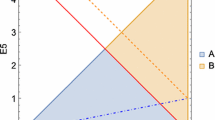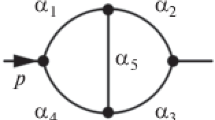Abstract
A new method of divergence subtraction in Feynman parametric integrals is presented. The method is suitable for calculating the lepton anomalous magnetic moments (AMM) in quantum electrodynamics (QED). The subtraction procedure eliminates all divergences before integration and leads to a finite Feynman parametric integral for each individual Feynman diagram. It is based on a forest formula with linear operators applied to the Feynman amplitudes of ultraviolet-divergent subdiagrams. The formula is similar to Bogoliubov–Parasiuk–Hepp–Zimmermann summation; the difference is only in the linear operators used and in the way of combining them. The subtraction is equivalent to the on-shell renormalization from the beginning: for obtaining the final result we should only sum up the contributions of all Feynman diagrams after subtraction. The developed method is an improvement of the method presented by the author in 2016. The modification is specifically designed for calculating the contributions dependent on the relations of particle masses. In comparison with the old version, the new subtraction formula does not contain redundant terms and possesses some flexibility that can be used for improving the precision of calculations. Numerical test results are presented up to four loops.



Similar content being viewed by others
REFERENCES
D. Hanneke, S. Fogwell Hoogerheide, and G. Gabrielse, “Cavity control of a single-electron quantum cyclotron: Measuring the electron magnetic moment,” Phys. Rev. A 83, 052122 (2011).
B. Abi et al. (Muon g-2 Collab.), “Measurement of the positive muon anomalous magnetic moment to 0.46 ppm,” Phys. Rev. Lett. 126, 141801 (2021).
G. W. Bennett et al. (Muon g-2 Collab.), “Final report of the E821 muon anomalous magnetic moment measurement at BNL,” Phys. Rev. D 73, 072003 (2006).
T. Aoyama, T. Kinoshita, and M. Nio, “Theory of the anomalous magnetic moment of the electron,” Atoms 7, 28 (2019).
R. Bouchendira, P. Clade, S. Guellati-Khélifa, F. Nez, and F. Biraben, “New determination of the fine structure constant and test of the quantum electrodynamics,” Phys. Rev. Lett. 106, 080801 (2011).
P. J. Mohr, D. B. Newell, and B. N. Taylor, “CODATA recommended values of the fundamental physical constants: 2014,” Rev. Mod. Phys. 88 035009 (2016).
R. H. Parker, C. Yu, W. Zhong, B. Estey, and H. Müller, “Measurement of the fine-structure constant as a test of the Standard Model,” Science 360, 191 (2018).
L. Morel, Z. Yao, P. Cladé, and S. Guellati-Khélifa, “Determination of the fine-structure constant with an accuracy of 81 parts per trillion,” Nature 588, 61–65 (2020).
S. Volkov, “Calculating the five-loop QED contribution to the electron anomalous magnetic moment: Graphs without lepton loops,” Phys. Rev. D 100, 096004 (2019).
T. Aoyama, N. Asmussen, et al., “The anomalous magnetic moment of the muon in the Standard Model,” Phys. Rep. 887, 1–166 (2020).
T. Aoyama, M. Hayakawa, T. Kinoshita, and M. Nio, “Complete tenth-order QED contribution to the muon g–2,” Phys. Rev. Lett. 109, 111808 (2012).
S. Volkov, “Subtractive procedure for calculating the anomalous electron magnetic moment in QED and its application for numerical calculation at the three-loop level,” J. Exp. Theor. Phys. 122, 1008–1031 (2016).
S. Volkov, “Numerical calculation of high-order QED contributions to the electron anomalous magnetic moment,” Phys. Rev. D 98, 076018 (2018).
S. Laporta and E. Remiddi, “The analytical value of the electron (g–2) at order α3 in QED,” Phys. Lett. B 379, 283 (1996).
S. Laporta, “The analytic value of the corner ladder graphs contribution to the electron g–2 in QED,” Phys. Lett. B 343, 421–426 (1995).
R. Barbieri, M. Caffo, E. Remiddi, S. Turrini, and D. Oury, “The anomalous magnetic moment of the electron in QED: Some more sixth order contributions in the dispersive approach,” Nucl. Phys. 144, 329—348 (1978).
M. J. Levine and R. Roskies, “Analytic contribution to the g factor of the electron in sixth order,” Phys. Rev. D 14, 2191 (1976).
M. J. Levine, R. C. Perisho, and R. Roskies, “Analytic contributions to the g factor of the electron,” Phys. Rev. D 13, 997 (1976).
M. J. Levine, E. Remiddi, and R. Roskies, “Analytic contributions to the g factor of the electron in sixth order,” Phys. Rev. D 20, 2068–2076 (1979).
M. J. Levine and R. Roskies, “Hyperspherical approach to quantum electrodynamics–sixth-order magnetic moment,” Phys. Rev. D 9, 421 (1974).
R. Barbieri and E. Remiddi, “Sixth order electron and muon (g-2)/2 from second order vacuum polarization insertion,” Phys. Lett. B 49, 468 (1974).
R. Barbieri, M. Caffo, and E. Remiddi, “A contribution to sixth order electron and muon anomalies,” Lett. Nuovo Cimento 9, 690 (1974).
D. Billi, M. Caffo, and E. Remiddi, “A contribution to the sixth-order electron and muon anomalies,” Lett. Nuovo Cimento 4, 657–660 (1972).
R. Barbieri, M. Caffo, and E. Remiddi, “A contribution to sixth-order electron and muon anomalies–II,” Lett. Nuovo Cimento 5, 769 (1972).
J. Mignaco and E. Remiddi, “Fourth-order vacuum polarization contribution to the sixth-order electron magnetic moment,” Nuovo Cimento A 60, 519 (1969).
S. Laporta and E. Remiddi, “The analytic value of the light-light vertex graph contributions to the electron (g–2) in QED,” Phys. Lett. B 265, 182–184 (1991).
S. Laporta, “The analytical contribution of the sixth order graphs with vacuum polarization insertions to the muon g–2 in QED,” Nuovo Cimento A 106, 675–683 (1993).
S. Laporta and E. Remiddi, “The analytical value of the electron light-light graphs contribution to the muon (g–2) in QED,” Phys. Lett. 301, 440—446 (1993).
A. Czarnecki and M. Skrzypek, “The muon anomalous magnetic moment in QED: Three loop electron and tau contributions,” Phys. Lett. 449, 354—360 (1999).
A. Kurz, T. Liu, P. Marquard, and M. Steinhauser, “Anomalous magnetic moment with heavy virtual leptons,” Nucl. Phys. B 879, 1–18 (2014).
ACKNOWLEDGMENTS
The author thanks Lidia Kalinovskaya, Gudrun Heinrich, Savely Karshenboim, Andrey Arbuzov for the important assistance, and Andrey Kataev for valuable consultations. Also, the author thanks the Laboratory of Information Technologies of JINR (Dubna, Russia) for providing an access to its computational resources and additionally the organizers of the conference FFK-2021 for providing a possibility to make a presentation. And beyond that, the author considers it proper to honor the memory of Fyodor Tkachov.
Author information
Authors and Affiliations
Corresponding author
Ethics declarations
The author declares that he has no conflicts of interest.
Rights and permissions
About this article
Cite this article
Volkov, S. A Method of Fast Calculaion of Lepton Magnetic Moments in Quantum Electrodynamics. Phys. Part. Nuclei 53, 805–810 (2022). https://doi.org/10.1134/S106377962204013X
Received:
Revised:
Accepted:
Published:
Issue Date:
DOI: https://doi.org/10.1134/S106377962204013X




